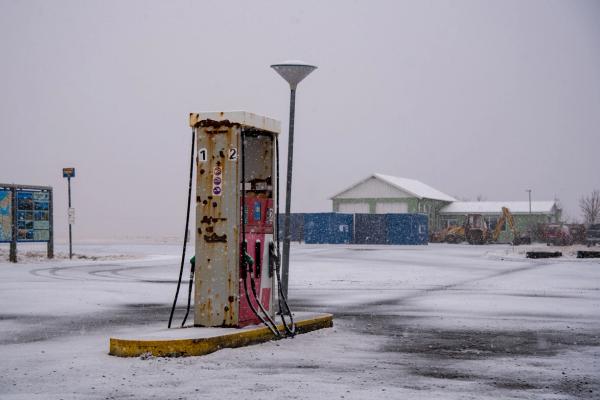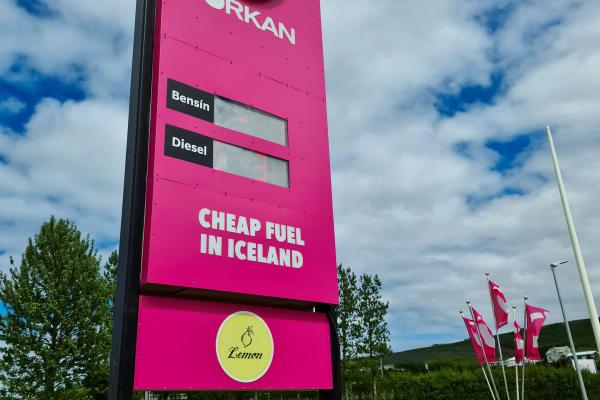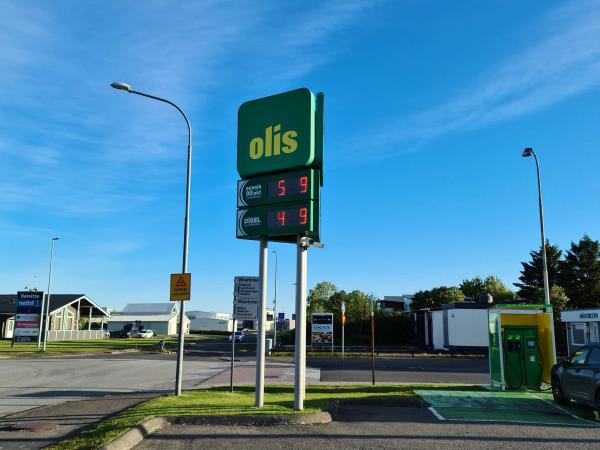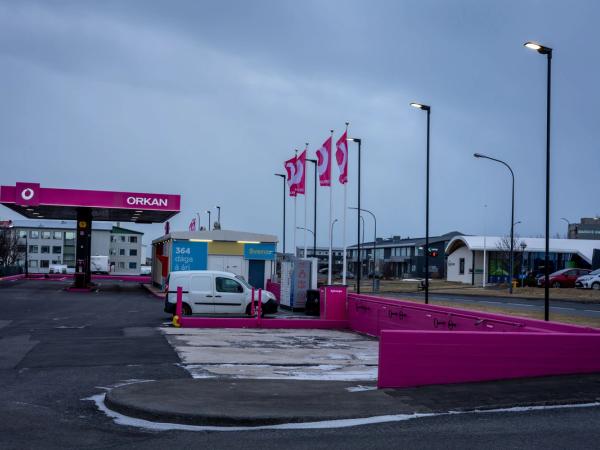
Driving around Iceland: A guide to gas prices
When you are planning a trip to Iceland, one of the first things that surely will come to your mind is how to get around to see all the marvelous places that this country has. The answer is easy. There’s no better way to discover the country than by car. Renting your own vehicle is the easiest way to go everywhere at your own pace.
Having your own car allows you to visit places inaccessible by public transportation. However, it’s normal to wonder how expensive fuel is in the country, as it’s a factor that can have an effect on your budget.
This guide will provide a look at gas prices in Iceland, where to find the best deals, and how to make the most of your trip while minimizing fuel costs.
Key Takeaways
- The average price for a liter of gasoline in Iceland is around $2.48 (€2.15). For diesel, the price is approximately $2.60/liter (2.25 €/liter).
- Fuel prices are relatively uniform in Iceland. However, some companies offer slightly better deals.
- Gasoline and diesel are expensive here, but there are some tips to economize your gas consumption.
Understanding Gas Prices in Iceland
Iceland’s fuel prices are some of the highest in the world. They are usually among the most expensive across Europe. This is due to several factors, including high taxes, fuel importation costs, and environmental policies aimed at reducing carbon emissions.
Iceland is heavily reliant on fuel imports, as the country has no domestic fossil fuel resources. Additionally, the Icelandic government imposes significant taxes on gasoline and diesel to encourage more eco-friendly alternatives and to compensate for the environmental impact of driving in such a delicate ecosystem.
Understanding the impact of fuel prices on your trip budget is crucial. If you plan on driving long distances or renting a larger vehicle, fuel costs can quickly add up. For this reason, it’s essential to plan everything carefully and maximize fuel efficiency whenever possible.

Current Gas Prices by Location and Supplier
While fuel prices in Iceland are generally uniform due to government regulations and taxes, slight variations can happen depending on the region and the supplier. Gas prices tend to be higher in more remote areas where transportation and supply costs are higher. For instance, gas stations in Reykjavik and other major cities may offer more competitive prices compared to those in regions with less population, like the Westfjords or the Central Highlands.
As of July 20th, 2025, the average price for a liter of gasoline in Iceland hovers around 304.72 ISK per liter. This is €2.15 or $2.48, which equates to roughly 9.38$ per gallon. The prices have decreased by 1.4% over the last three months.
Diesel is generally cheaper than gasoline, but it's not at the moment. The average price for a liter is approximately 319.67 ISK, equivalent to 2.25 €/liter or $2.60/liter. That makes the gallon price 9.84$. Diesel prices in Iceland have decreased by 0.7% over the last trimester.
These prices can change depending on the global oil market, local taxes, and the station’s location.
Most gas stations in Iceland are self-service, and many of them are open 24/7. Payment is usually made via credit or debit cards at the pump. However, some stations only accept credit cards with a PIN, which can be an inconvenience for travelers unfamiliar with this system.
Urban vs. Rural Pricing Differences
In urban areas like Reykjavik and Akureyri, where competition between suppliers is more prevalent, prices tend to be slightly lower. On the other hand, rural areas, particularly in the Highlands or along less frequently traveled routes, often have higher prices. This is mainly due to the logistical challenges of transporting fuel to these remote locations.

Gas Station Companies
There are several major gas station companies operating in Iceland, each offering different services and benefits.
- N1: The largest fuel provider in Iceland, N1 stations are found almost everywhere in the country, including remote areas. N1 stations offer 24/7 service and have a reputation for reliability, making them a favorite among tourists. They also have prepaid fuel cards available, which are particularly useful to avoid international transaction fees.
- ÓB: ÓB is a budget-friendly option. However, their stations can’t be found all over the country, so it’s important to check ahead if you’re planning a long drive in less frequented regions.
- Orkan: Another budget-friendly option, Orkan offers discounted fuel at some locations. Their stations are primarily located in urban areas, so they are a good option if you’re planning to stay close to Reykjavik.
- Atlantsolía: Atlantsolía, a smaller company, is known for offering relatively lower fuel prices, especially in the Reykjavik area. However, their stations are not as widely distributed as other companies.
Gas Station Chains and Their Prepaid Cards
Some gas stations use a prepaid fuel card system. Chains like N1, the main supplier in Iceland, have these cards available. They can be purchased at most N1 stations or select supermarkets, and they allow you to preload an amount and use it to pay for fuel. The prepaid card system can help avoid international transaction fees that can be applied to credit card payments.
Gasoline vs. Diesel: Which one is Better?
At the moment of choosing a rental car, many tourists have to face the decision of whether to rent a gasoline or diesel vehicle. Both options have their pros and cons, depending on your travel plans and budget.
Gasoline
Gasoline-powered vehicles are more common in Iceland, especially for smaller cars. While gasoline prices are higher than diesel, smaller vehicles typically consume less fuel, which can make up for the price difference. If your trip mainly involves short drives around Reykjavik or nearby attractions, a gasoline vehicle may be the most cost-effective choice.
Diesel
Diesel vehicles are a popular choice for long road trips, particularly for those planning to drive the Ring Road or go to more remote areas. Diesel usually offers better fuel efficiency, especially for larger vehicles such as vans or SUVs. Diesel engines are also known for their durability and performance on Iceland’s rugged terrain.

Driving Efficiency in Iceland
As we have seen, fuel prices are not especially cheap in Iceland. For this reason, it’s a good idea to drive efficiently to avoid increasing the cost of your trip. There are several tips that can help you reduce costs.
- Maintain a steady speed: Speed limits in Iceland are relatively low—90 km/h on paved roads and 80 km/h on gravel roads. Sticking to these limits can save fuel.
- Don’t keep the engine on: Many travelers feel the need to keep the car on so they don’t cool down too much in cold weather. Modern engines require only a few minutes to warm up, and keeping them on burns fuel unnecessarily and is harmful to the environment.
- Don’t carry too many things: Carrying unnecessary weight in your vehicle can increase fuel consumption. Try to reduce the things you’re taking on excursions and only bring essential items.
- Use Cruise Control: On long, straight parts of the road, especially on the Ring Road, using cruise control can help you maintain a consistent speed and improve fuel efficiency.
- Plan Your Route: Knowing where the next gas station is located can help prevent unnecessary detours. Iceland’s remote regions, particularly the Highlands, don’t have many stations. For this reason, it’s a good idea to fill up the tank if you’re going to these areas.
Travel Tips
Fuel costs can be a considerable part of your travel expenses, but with some smart planning, you can minimize these costs.
- Prepaid gas cards: As we mentioned earlier, prepaid gas cards from N1 stations allow you to manage your fuel budget effectively. They are also helpful to avoid transaction fees that some banks impose on foreign credit card payments.
- Fuel discount apps: Several apps track fuel prices across Iceland in real-time, allowing you to find the cheapest fuel near your location. Using these apps can help you save a few kronor.
- Fill up in urban areas: Gas stations in Reykjavik and other cities typically offer the best prices. If possible, try to fill up before leaving urban areas, as prices tend to rise in more remote regions.
Conclusion
Driving in Iceland offers an unparalleled way to explore the country’s diverse landscapes. Here you can find volcanoes, glaciers, lava fields, geothermal spas, and much more. And there’s no better way to go to all these amazing places than by car.
However, the high cost of fuel in the country can shock many visitors. By understanding Iceland’s fuel pricing system, choosing the right vehicle, and following tips for driving efficiency, you can enjoy your trip while keeping fuel expenses as low as possible.



